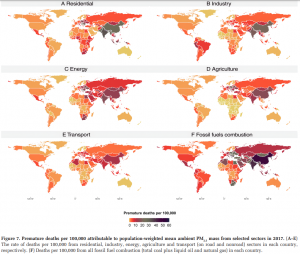While the COVID-19 pandemic has dominated headlines, another invisible and insidious health threat continues to rage, causing lost workdays, emergency room visits and hospitalizations. Fine particle air pollution (PM2.5) is the sixth-highest risk factor for deaths globally, accounting for nearly four million deaths in 2019 alone, according to the Health Effects Institute’s (HEI) State of Global Air. A million of these deaths are the direct result of the burning of fossil fuels. Air pollution is a global public health crisis, and we need to take urgent steps to address it.
To mount an effective fight against air pollution—and PM2.5 in particular—we need a better understanding of its sources and impacts, as they vary dramatically from country to country and community to community. This week, HEI released a new report that sheds light on the issue. The “Global Burden of Disease from Major Air Pollution Sources (GBD MAPS)” provides the first comprehensive analysis estimating major sources of air pollution for every country in the world. The study team, led by Dr. Erin McDuffie and Dr. Randall Martin of Washington University in St. Louis, and Dr. Michael Brauer at The University of British Columbia, found that:
- Fossil fuel combustion contributed to more than one million deaths globally in 2017. Half of that was due to coal combustion; the other came from oil and gas emissions.
- Major sources of PM5 vary by country and region, and air pollution impacts differ across the globe.
- While fossil fuel combustion made up most of the PM5 across industrialized nations of the global north, windblown dust was a major source of PM2.5 in African countries.
- A majority of outdoor PM5 health effects are due to human activities related to the burning of fuel for heating, transportation, industry and other energy needs, suggesting that integrating air quality, energy, and climate policies is likely to bring substantial health benefits.
Different sources had varying impacts across countries.
While coal, oil and gas combustion resulted in a large burden of disease due to air pollution, the fractional share of these sources varied across countries. Residential contributions ranged from 4.0% in Egypt to 33.1% in Indonesia, while energy and industrial emissions combined ranged from 3.2% in Nigeria to 27.3% in India.
The report also tallies the fractional contribution of fuels across different sectors to PM2.5 attributable premature deaths at the country level. This provides additional insight for national action plans to reduce the health burden of fine particulate air pollution. For example, coal from the energy sector contributes to a greater share of attributable deaths (20.5%) in South Africa than from the industry sector (2.7%). The opposite is true for China, where 4.7% of attributable deaths come from coal associated with the energy sector, while 9.1% come from industry sector coal. The figure from the HEI McDuffie et al report shown here, demonstrates the varying impacts of sources across different countries.

Not everyone breathes the same air within countries or even cities
The report also found a large variation in air pollution and its impacts on health within countries. In 2019, there was a 3-fold variation in economic losses due to premature deaths and disease attributable to air pollution between the states in India. For example, in Pune (where my parents live), annual average fine particulate air pollution levels were 40 µg/ m3 (the Indian National Ambient Air Quality Standard for PM2.5), while concentrations were below 20 µg/m3 in Kozhikode and over 140 µg/m3 in New Delhi. Differences in economic activity, energy sources, population distribution, agricultural and cooking practices as well as atmospheric patterns, can all cause variations in health burdens across cities .
We know that variation within cities may be even greater. Environmental Defense Fund and our partners found a 5-fold variation in health impacts of particle pollution in the San Francisco Bay Area. In Houston and London, we’ve focused on identifying sources that contribute to pollution hot spots. We are now conducting similar work in cities around the world .
To develop smart strategies to improve public health, policymakers need a better picture of air pollution at all scales—from the country perspective down to the city level. Knowing where pollution is coming from, who it impacts and who is responsible for it provides communities, governments and companies with highly actionable information they can use to develop policies that make meaningful impacts.
